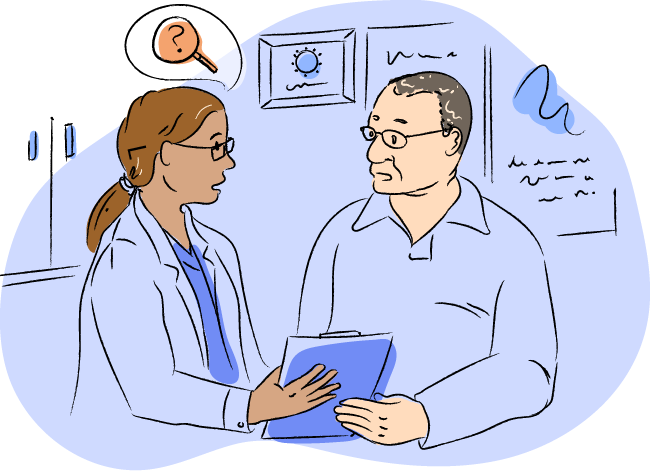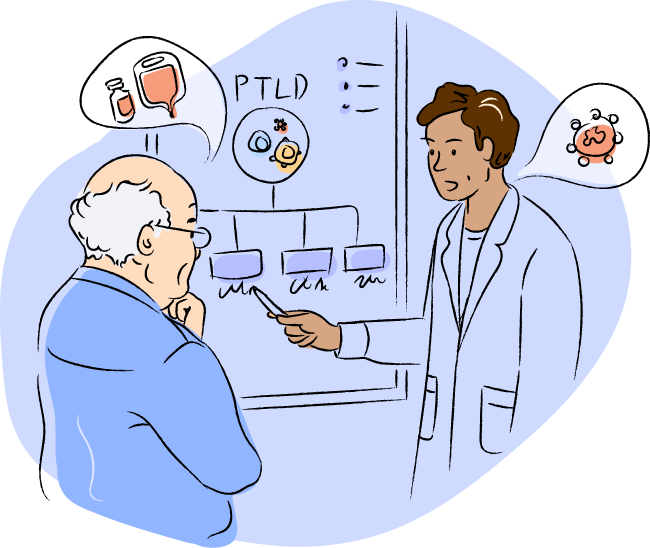
Diagnosis and treatment
PTLD is related to your transplant and immunosuppressants. Your transplant team needs to be aware so they can diagnose and treat it quickly.

PTLD is related to your transplant and immunosuppressants. Your transplant team needs to be aware so they can diagnose and treat it quickly.
Your transplant team will review your medical and transplant history. They may also ask you to meet with other healthcare providers. You may have to go in for:
Common types of tissue samples taken:
Common types of imaging:
Afterwards, your transplant team will run tests on the tissue samples and analyze the results. Two important tests are immunophenotyping and looking at levels of EBV.
Ask your transplant team if you have questions about PTLD. You can do this even if you haven't seen them in a while. They are the experts on your transplant history and the immunosuppressants you are taking.
If you can't see your transplant team right away, see your primary care provider, or if under 18, a pediatrician. They may be able to reach the transplant team for you.

PTLDs range from mild, benign growths to aggressive cancers.
When your transplant team is analyzing the results of diagnostic tests, they are trying to understand:
These three factors, and whether the PTLD is new or has come back, will affect the treatment plan.
PTLD affects your lymphocytes. In most cases, your B cells are affected, but PTLD can also affect T cells and natural killer (NK) cells.
EBV can be linked to the development of PTLD. If there is a link to EBV, it's called EBV‑positive PTLD. If there is no link, it's called EBV‑negative PTLD.
The World Health Organization (WHO) has four categories for growths and lymphomas that are considered PTLDs. You may hear your doctor use these categories or the name of the growth or lymphoma.
There are many types of treatment. The treatment options available to you will depend on factors like:
Since PTLD involves the immune system, many of the treatment options are immunotherapies. Immunotherapies work by helping the immune system to fight a disease.
Your immunosuppressants may be carefully adjusted by your transplant team. This is done to help your immune system control PTLD while keeping your transplant healthy.
Antibody therapy helps the immune system recognize and fight specific cells. In PTLD, it may be used to target B cells.
CAR T-cell therapy is made from the patient's T cells. The patient's T cells are genetically modified in the lab to attack specific types of cancer cells.
Chemotherapy kills cells that grow and multiply quickly, including cancer cells. When it is used with antibody therapy, it's called chemo-immunotherapy.
Clinical trials are research studies. In a clinical trial, patients may receive an existing treatment or a new treatment that is being studied.
EBV-directed therapy targets and kills cells that are infected by EBV. It is used to treat diseases linked to EBV, including EBV‑positive PTLD.
Surgery and radiotherapy are not usually used to treat PTLD. They may be used to control or reduce symptoms.
There may be other treatment options not listed here.
You can work with your transplant team to create a treatment plan. You can write down questions that come to mind over time and have a caregiver help take notes. There are no stupid questions.

Your transplant team will need to be involved. This is because PTLD is related to your transplant and immunosuppressants. You may also see other specialists, depending on your transplant type, age, and other health conditions.
post‑TRANZ-plant LIM-foh-proh-LIH-feh-ruh-tiv dih-ZEEZ or dis-OR-der
PTLD stands for:
'Lympho' refers to lymphocytes, a type of white blood cell.
'Proliferative' means growing or multiplying quickly.
PTLD is when your lymphocytes grow out of control after a transplant. It can develop in anyone taking immunosuppressants after a transplant.
PTLD is a group of diseases. It includes certain kinds of growths and lymphomas. PTLD can become life-threatening. It needs to be brought up to the transplant team so they can diagnose and treat it quickly.
PTLD is often linked to the Epstein‑Barr virus (EBV). If there is a link, it's called EBV‑positive PTLD. If there is no link, it's called EBV‑negative PTLD.
IH-myoo-noh-FEE-noh-ty-ping
Immunophenotyping is a lab test that tells white blood cells apart by the features or 'markers' on their surface. The results help doctors diagnose diseases like lymphomas and PTLDs. The test is done on tissue samples, like blood and bone marrow.
ep-stine-BAR VY-rus
EBV is one of the most common viruses that people can get. It is also known as human herpesvirus 4.
Most adults will have had an EBV infection and carry EBV without any symptoms. EBV may cause symptoms in people with a weakened immune system.
lim-FOH-muh
Lymphoma is a type of blood cancer that begins in your lymphocytes. Lymphocytes are a type of white blood cell. There are two main types of lymphoma:
Certain lymphomas that appear after a transplant are considered PTLDs.
LIM-foh-sites
Lymphocytes are white blood cells. They are a part of your immune system. There are three main types:
Each type of lymphocyte protects your body from infections and diseases in its own way.